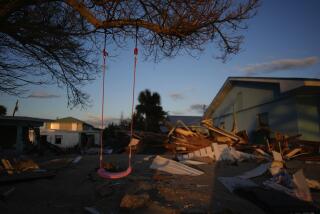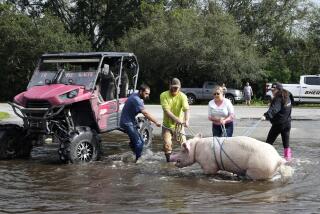Florida Banking on River Restoration Plan
- Share via
ON THE KISSIMMEE RIVER, Fla. — The dying, white branches of wax murtle trees protrude like skeletons along the banks of the restored Kissimmee River.
The dry-soil trees can’t survive in water several feet deep that covers land surrounding the river for the first time in 30 years. The flooding is a result of a massive restoration project to return a portion of the Kissimmee to its old, meandering course.
“The dead and dying trees are a good sign,” said Paul Whalen, the project’s director.
Wax murtle took over the landscape after the federal government drained the 103-mile snaking Kissimmee River in the 1960s into 56 miles of straight canal dug from Lake Kissimmee to Lake Okeechobee for flood control.
The channelization was successful in protecting booming central Florida cities such as Orlando and Kissimmee, but reduced the river, the headwaters of the Everglades, to a trickle. It dried up two-thirds of the surrounding marsh and forced wildlife, including the bald eagle, to look for habitat elsewhere.
The loss of wax murtle trees is just one sign the project is working.
The first of four phases was completed in February, but the region’s severe drought delayed restoration until the summer rains.
Now, for the first time in 40 years, boats navigate 15 miles of twisting river that steamboats plied a century ago. Water spills out over the banks, nourishing a mile-wide flood plain that had been drained cow pastures. Wading birds and wintering waterfowl have returned.
“Seeing the birds come back is an important signpost to demonstrate that we’re being good stewards,” said Norman Moss, president of the Kissimmee Valley Audubon Society.
The rest of the $500 million state-federal project is slated for completion by 2010. The goal is to allow the river and its flood plain to become a wetland again, providing habitat to more than 300 fish and animal species.
The project is considered the nation’s most ambitious river restoration. In all, 22 miles of canal will be back-filled, 43 miles of river will be restored and 27,000 acres of the original 40,000-acre flood plain will recover.
“There is no other restoration project that I’m aware of that will benefit so many fish and wildlife species,” said Lou Toth, South Florida Water Management District’s lead scientist on the project.
The first phase began in 1999 after years of studies that got underway immediately after the U.S. Army Corps of Engineers completed the channelization in 1971.
The Corps used front loaders and dump trucks to fill 7 1/2 miles of canal north of Lake Okeechobee near the Avon Park Bombing Range. On a recent media tour, project scientists pointed to cattails and a native, wetland shrub called the Carolina willow that are flourishing where water once flowed unobstructed.
The Corps also re-carved two miles of oxbows that were lost beneath spoil displaced during construction of the canal, which is 300 feet wide and 30 feet deep.
Restoration of the next section of historic river bed will begin in about three years. However, only the river’s central portion will be restored. More than half the canal will continue providing flood control.
Not everyone supports the recovery. Rancher Pete Clemons said the water district filled in creeks that had emptied into the river, causing flooding on cattle pastures. Some of his land was among the 90,000 acres the state bought for the restoration.
Clemons is skeptical, saying he hasn’t seen many benefits.
“Once you upset it you can’t restore it,” he said.
Toth said it will be five years before the ecosystem fully returns to the way it was before channelization. He expects blue gill and largemouth bass to be plentiful in a river once nationally recognized for its sports fishing.
A loss of oxygen caused fish populations to drop by half after channelization. Oxygen is created when water is stirred up, but there wasn’t much turbulence in the slow-moving canal. Plus, air wasn’t able to re-oxygenate the water on the bottom of the deep ditch.
Water district bird specialists recently counted wood storks for the first time in six years. They also documented the migrating blue-winged teal, white ibis, herons and egrets.
Toth said the environmental benefits will extend beyond the Kissimmee River.
New marsh plants will filter out phosphorous, improving the quality of water flowing into Lake Okeechobee. The wide wetland will be a new refuge for waterfowl and wading birds that lose their Everglades habitat in the dry season. The Kissimmee flood plain remains wet year-round, except in severe drought.
Rancher and project engineer Rick Luna has watched the Kissimmee transform during his 49 years on the river.
Luna grew up jumping off tree swings dangling over the river, and as a youth he monitored pumps during the canal’s construction. Most recently, he was a contractor on the canal back-filling project.
He is confident the restoration will return the river to its old glory.
“When I was a kid you could sit here and catch a stringer-full of fish,” he said, standing under an oak tree at the river’s edge. “It’s coming back.”
More to Read
Sign up for Essential California
The most important California stories and recommendations in your inbox every morning.
You may occasionally receive promotional content from the Los Angeles Times.










